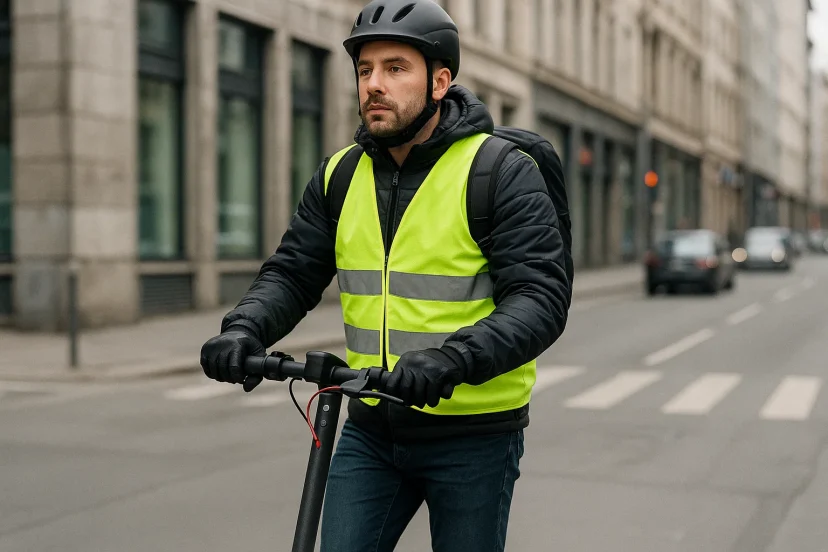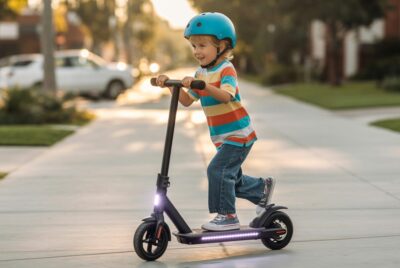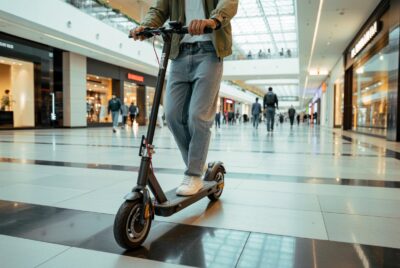E-Scooter Safety in 2025: Data-Driven Insights
*We may earn a commission for purchases made using our links. Please see our disclosure to learn more.
The electric scooter revolution has transformed urban mobility, with over 158 U.S. cities now operating e-scooter systems as of 2022. However, as these convenient micro-mobility devices become increasingly popular, safety concerns have emerged alongside their rapid adoption. Understanding the current state of e-scooter safety in 2025 requires examining comprehensive data, evolving regulations, and the ongoing challenges that riders face daily.
“Our findings stress a concerning trend: helmet usage is noticeably lower among electric vehicle riders compared to conventional bicyclists and scooter riders.”
– UC San Francisco research study
Key Takeaways
- Injury rates are climbing: E-scooter, e-bike, and hoverboard injuries have increased by 70% over the past four years
- Helmet usage remains low: Studies show significantly lower helmet adoption among e-scooter riders compared to traditional bicyclists
- Age demographics vary: The median age for injured e-scooter riders is 30, with diverse user groups including women and minorities
- Regulatory improvements: Many states have implemented or strengthened helmet requirements, particularly for riders under 18
- Technology advances: Modern e-scooters feature better braking systems, lighting, and stability controls compared to earlier models
Top 4 E-Scooter Safety Products on Amazon
Zacro Adult Bike Helmet
Stay protected while you ride with the Zacro Adult Bike Helmet, designed for both men and women who value comfort, style, and E-scooter safety. Certified to meet U.S. and European safety standards, this helmet features a durable polycarbonate shell paired with high-density EPS foam for superior impact absorption. The 19 strategically placed air vents ensure a cool, breathable ride—even in hot weather—while the removable visor and inner pads offer added comfort and easy maintenance. Whether you're commuting in the city or cruising on an electric scooter, the Zacro helmet provides the right fit and peace of mind for everyday riders.
If you’re prioritizing E-scooter safety in 2025, investing in a high-quality helmet is essential—and the Zacro Adult Bike Helmet fits the bill perfectly. With electric scooter usage surging in urban and suburban areas, protective gear that combines durability, ventilation, and comfort is a must. Zacro’s helmet is designed for everyday riders, featuring CE and CPSC certification, a solid polycarbonate shell, and impact-absorbing EPS foam to protect against head injuries. The lightweight build and 19 vents prevent overheating on summer rides, while the adjustable fit ensures it stays snug at any speed.
- Safety Certified: Meets CE and CPSC safety standards for reliable E-scooter and bike protection.
- Comfort-First Design: Features 19 vents and moisture-wicking pads for a cool, sweat-free experience.
- Adjustable Fit: Easily customizable dial and side straps to suit most adult head sizes.
- Limited Color Options in Some Sizes: Popular colors may not be available in every size.
- Not Ideal for Extreme Sports: Best suited for standard biking or e-scooter commuting—not high-impact activities.
- Visor Attachment Could Be Tighter: The detachable visor may need occasional adjustment.
Zacro LED Reflective Vest
Enhance your E-scooter safety and nighttime visibility with the Zacro LED Reflective Vest, built for both adult riders and kids aged 8+. This high-visibility vest features 360° reflective lighting using 5 vibrant LED colors and 3 lighting modes, ensuring you remain visible up to 1000 feet—even in fog, rain, or complete darkness. With dual USB-C fast charging and a runtime of up to 20 hours, it’s designed for daily commutes or recreational night rides. Lightweight, breathable, and adjustable, it comfortably fits all body types, making it a smart and essential piece of gear for safe electric scooter travel.
Perfect for electric scooter enthusiasts who ride at dawn, dusk, or night, the Zacro vest is not only USB-rechargeable and lightweight, but also fully adjustable, making it ideal for adults and older children. Whether you’re navigating a busy city street or a dim suburban path, this vest ensures that drivers, cyclists, and pedestrians can see you from hundreds of feet away.
- High Visibility Lighting: 360° coverage with bright LEDs makes riders highly visible at night.
- Rechargeable Convenience: Fast-charging via USB-C with up to 20 hours of runtime.
- Universal Fit: Stretchy, adjustable design fits men, women, and kids with ease.
- Button Operation Can Be Tricky: Requires long press or cycling through modes to turn off.
- Not Fully Waterproof: Resistant in light rain, but not ideal for heavy downpours.
- Single Vest per Purchase: For group rides, multiple purchases are necessary.
JBM Adult & Kids Protective Gear Set
Stay fully protected while riding with the JBM Adult & Kids Protective Gear Set, ideal for scooters, skateboarding, rollerblading, and more. Featuring durable EVA padding and tough plastic plates, this set includes knee pads, elbow pads, and wrist guards to help prevent injury during falls and collisions. With adjustable elastic straps for a custom fit and breathable fabric for all-day wear, this gear ensures reliable E-scooter safety for riders aged 12 and up. Whether you're new to electric scootering or a seasoned rider, this lightweight, impact-resistant set has your safety covered.
Designed for users aged 12 and up, this all-in-one set is made with impact-resistant plastic shells and soft EVA foam padding, absorbing shocks and reducing abrasions during falls. It’s a must-have for anyone riding on uneven terrain, in busy streets, or at higher speeds. Unlike basic helmets alone, this kit covers your knees, elbows, and wrists, which are some of the most injury-prone areas in scooter accidents.
- Full Body Coverage: Includes wrist, elbow, and knee protection for comprehensive safety.
- Adjustable Fit: Elastic straps adapt to different sizes for teens and adults.
- Durable Materials: Strong plastic shells and soft EVA foam offer effective impact protection.
- Limited Breathability: May feel warm in hot weather due to thick padding.
- Bulky for Light Rides: Better suited for high-speed or high-risk activities.
- Not Gender-Specific Fit: One-size approach may need adjusting for slimmer body types.
FLDYYG Electric LED Scooter Lights
Light up your ride and stay visible with the FLDYYG Electric LED Scooter Lights, designed to enhance E-scooter safety during nighttime or low-light rides. Each pack includes 2 waterproof LED light strips, 10 zip ties, a bundled pouch, and a mini screwdriver for easy setup. With a low-voltage, heat-insulated design, these lights are safe to touch and great for kids, teens, or adults. Perfect for scooters, bikes, or even as decorative lights around the home, they add vibrant color and increase visibility on the road.
These waterproof, low-voltage LED strips offer 360° visibility with vibrant colors and long-lasting illumination. Ideal for kids, teens, and adults, the lights attach easily to the frame of your scooter or bicycle and stay cool to the touch, making them safe for hands-on adjustments. Not only do they improve your visibility to drivers and other pedestrians, but they also bring style and personality to your ride.
- Enhanced Visibility: Bright multicolor LED strips make riders more noticeable in low light.
- Safe and Cool to Touch: Low-voltage design prevents overheating, even with extended use.
- Multi-Use Functionality: Can be used on bikes, scooters, skateboards, or for decorative lighting.
- Manual Installation Required: Setup may take time with zip ties and screwdriver.
- Not Rechargeable: Requires external power or battery setup (not included).
- Shorter Length: 30cm strip may not fully light larger scooters or bikes.
The Current Safety Landscape
The data paints a complex picture of e-scooter safety in 2025. Injuries related to using e-scooters, e-bikes, and hoverboards have increased by 70% over the past four years, indicating that while these devices offer convenient transportation, they also present significant safety challenges.
A study by the U.S. Consumer Product Safety Commission found approximately 209,600 emergency room visits by escooter riders between 2017 and 2023, highlighting the scope of the safety issue. These numbers represent real people whose lives have been affected by e-scooter incidents, underscoring the importance of understanding and addressing safety concerns.
Who’s Getting Injured and Why
The demographics of e-scooter injuries reveal interesting patterns. The median age for e-scooter riders involved in accidents was 30 compared to 11 for conventional scooter riders, suggesting that adults are the primary users of electric scooters. This age difference also indicates that e-scooters attract users who might not otherwise use traditional scooters.
Injured e-scooter users were more diverse, including a higher proportion of women and minorities, and tended to be younger than bicyclists and e-bike users. This diversity in the user base presents both opportunities and challenges for safety education and equipment design.
The Helmet Problem
One of the most concerning trends in e-scooter safety is the low rate of helmet usage. Studies show that helmet usage is noticeably lower among electric vehicle riders compared to conventional bicyclists and scooter riders. This disparity in safety equipment usage contributes significantly to the severity of injuries when accidents occur.
The convenience factor of shared e-scooters plays a role in this problem. Unlike personal bikes, where riders can store their helmets at home, shared e-scooters require users to carry protective equipment with them or forgo it entirely. This practical challenge has led to various policy responses and technological solutions.
Regulatory Evolution and Enforcement
The regulatory landscape for e-scooters has evolved significantly since their introduction. Many states now require helmets for riders under 18, recognizing the particular vulnerability of younger users. However, enforcement remains inconsistent across different jurisdictions.
Some states require a valid driver’s license or learner’s permit for e-scooter riders, treating these devices more seriously than traditional kick scooters. This regulatory approach acknowledges the higher speeds and greater risks associated with electric scooters.
Collision Patterns and Risk Factors
Understanding how e-scooter accidents occur provides valuable insights for improving safety. E-bike injuries were more likely to involve a motor vehicle (33%) than bicycle (26%) and e-scooter injuries (23%), suggesting that while e-scooters do interact with motor vehicles, the rate is slightly lower than other cycling modes.
Collisions with cars travelling at 40 km/h can cause severe to fatal head injuries to e-scooter riders, emphasizing the critical importance of protective equipment and safe riding practices. The study also found that inexperienced drivers often ride at maximum speeds despite being unsafe on the road, highlighting the need for better education and training.
The Speed Factor
Speed regulation has emerged as a crucial safety consideration. Most jurisdictions now impose maximum speeds of 15 mph for e-scooters, balancing mobility benefits with safety concerns. This speed limit reflects research showing that higher speeds dramatically increase injury severity in accidents.
The challenge lies in enforcement and rider behavior. Many e-scooters are capable of exceeding legal speed limits, and inexperienced riders may not understand the risks associated with higher speeds. This disconnect between capability and safe operation continues to contribute to accident rates.
Infrastructure and Environmental Factors
E-scooter safety doesn’t exist in a vacuum, it’s heavily influenced by urban infrastructure and environmental conditions. Sidewalk riding is prohibited in most jurisdictions, forcing e-scooter users to share road space with cars and cyclists. This policy decision, while protecting pedestrians, increases the risk of vehicle-scooter collisions.
The lack of dedicated e-scooter infrastructure in many cities compounds these challenges. Without proper lanes or parking areas, riders must navigate complex traffic situations while competing for space with other road users. Weather conditions, road surface quality, and visibility also play crucial roles in accident prevention.
Technology’s Role in Safety Improvements
Modern e-scooters incorporate numerous safety improvements compared to earlier models. Better braking systems, improved lighting, and more stable designs have made current generation e-scooters safer than their predecessors. However, these technological advances haven’t eliminated the fundamental challenges of sharing urban space with other vehicles and pedestrians.
Some manufacturers have introduced features like speed limiting based on location, automatic headlights, and improved stability control. These innovations represent positive steps toward safer e-scooter design, though their real-world impact on accident rates requires further study.
Looking Forward: Challenges and Opportunities
The future of e-scooter safety depends on addressing multiple interconnected challenges. Education remains crucial—many riders lack proper training or understanding of safe operating practices. Unlike cars, which require licensing and testing, e-scooters can be operated immediately by anyone who can access them.
Infrastructure development presents another opportunity for improvement. Cities that invest in dedicated micro-mobility lanes and proper parking facilities tend to see better safety outcomes. However, such infrastructure requires significant investment and political will.
The Path to Safer Riding
Creating a safer e-scooter environment requires action from multiple stakeholders. Manufacturers must continue improving safety features and design. Policymakers need to develop coherent regulations that balance mobility benefits with safety concerns. Cities must invest in appropriate infrastructure to support safe e-scooter use.
Individual riders also play a crucial role in improving safety outcomes. Wearing appropriate protective equipment, following traffic laws, and understanding the capabilities and limitations of e-scooters all contribute to safer riding experiences. The convenience of e-scooters should never come at the expense of personal safety.
Building a Safety-First Culture
The ultimate goal is creating a culture where e-scooter safety is prioritized without sacrificing the mobility benefits these devices provide. This requires changing attitudes about protective equipment, improving rider education, and developing systems that make safe choices the easy choices.
Success in e-scooter safety won’t be measured solely by reduced accident rates—though that’s certainly important. It will also be measured by increased confidence in these transportation options, broader adoption across diverse communities, and the successful integration of e-scooters into comprehensive urban mobility systems.
Conclusion
E-scooter safety in 2025 represents a complex challenge requiring coordinated responses from manufacturers, policymakers, cities, and riders themselves. While injury rates have increased alongside adoption, this trend isn’t inevitable. Through improved technology, better infrastructure, stronger regulations, and enhanced education, the safety profile of e-scooters can be significantly improved.
The data shows both the challenges and opportunities ahead. With millions of e-scooter trips taken annually, even small improvements in safety rates can prevent thousands of injuries. The key is maintaining focus on safety improvements while preserving the mobility benefits that make e-scooters attractive to users.
As cities continue to evolve their transportation systems, e-scooters will likely play an increasingly important role. Ensuring that role is played safely requires ongoing commitment from all stakeholders and recognition that convenience and safety aren’t mutually exclusive goals.
Frequently Asked Questions
Q: Are e-scooters becoming safer in 2025 compared to previous years?
A: While e-scooter technology has improved with better braking systems and lighting, overall injury rates have increased by 70% over the past four years. This increase is largely due to higher usage rates rather than decreased safety per trip.
Q: Do I need to wear a helmet when riding an e-scooter?
A: Helmet requirements vary by state and age. Most states require helmets for riders under 18, while some jurisdictions have universal helmet requirements. Regardless of legal requirements, helmets significantly reduce the risk of head injuries.
Q: What’s the safest speed to ride an e-scooter?
A: Most jurisdictions limit e-scooter speeds to 15 mph, which balances mobility with safety. However, the safest speed depends on conditions—slower speeds are appropriate in crowded areas, poor weather, or when visibility is limited.
A: Both have advantages and disadvantages. Shared e-scooters are typically newer and better maintained, but users may be less familiar with the specific device. Private e-scooters allow for consistent maintenance and familiarity but may not receive regular safety updates.
Q: What should I do if I’m involved in an e-scooter accident?
A: First, seek medical attention if injured. Document the scene with photos, gather witness information, and report the incident to local authorities if required. If using a shared e-scooter, also report the incident to the company. Consider consulting with a personal injury attorney for serious accidents.
















